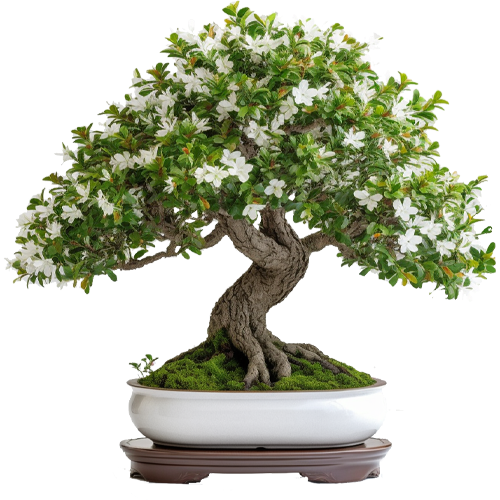Myrtle bonsai trees require bright sunlight, moderate watering, and regular pruning. They thrive in well-drained, slightly acidic soil.
Myrtle bonsai trees, known for their fragrant flowers and evergreen foliage, make beautiful indoor and outdoor plants. They need at least six hours of sunlight daily, preferably in a spot that receives morning sun. Water the tree when the topsoil feels dry, ensuring the soil is never soggy.
Pruning helps maintain their shape and encourages new growth. Use well-draining soil with a slightly acidic pH to keep the roots healthy. Regular fertilization during the growing season supports robust development. With proper care, a Myrtle bonsai can flourish and add charm to any space.
Introduction To Myrtle Bonsai
The Myrtle Bonsai tree has a rich history. It originated in the Mediterranean region. Ancient Greeks and Romans admired its beauty. They used it in many ceremonies and rituals. The tree symbolizes love and peace. It spread to other parts of the world over time. Gardeners and bonsai enthusiasts cherish this tree today.
Myrtle Bonsai trees have small, dark green leaves. These leaves are aromatic and fragrant. The tree produces white or pink flowers. These flowers are star-shaped and very pretty. The bark of the tree is smooth and gray. It often peels to reveal a reddish-brown layer. Myrtle Bonsai can also produce small blue-black berries. These berries are edible and have a unique taste.

Credit: miyagibonsai.co.uk
Choosing The Right Myrtle Bonsai
Picking a healthy Myrtle Bonsai tree is crucial. Look for vibrant green leaves. Avoid trees with yellow or brown spots. Check the trunk and branches for any damage. The soil should be moist but not soggy. Ensure the roots are not overcrowded or coming out of the pot. A sturdy trunk and well-spread roots indicate a healthy tree.
Certain varieties of Myrtle make better bonsai. The Common Myrtle (Myrtus communis) is popular. It has aromatic leaves and small white flowers. Another great choice is the Dwarf Myrtle. It is easier to shape and maintain. Some prefer the Variegated Myrtle. It has unique leaf patterns. Choose the variety that suits your style best.
Planting And Repotting
Myrtle bonsai trees need well-draining soil. A mix of akadama, pumice, and lava rock works best. The soil should retain some moisture but not stay too wet. It helps the roots get enough air.
Repot the myrtle bonsai every 2-3 years. Spring is the ideal time. Gently remove the tree from its pot. Trim about one-third of the roots. Place the tree in fresh soil.
Make sure the new pot has drainage holes. Water the tree thoroughly after repotting. This helps settle the soil around the roots. Keep the tree in a shaded area for a week. This gives it time to adjust.

Credit: m.youtube.com
Watering Guidelines
The Myrtle bonsai needs water every few days. Check the soil before watering. The soil should be slightly dry. Avoid letting the soil dry completely. Use lukewarm water for best results. Water the tree until water drains out the bottom. Be consistent with your watering schedule. This helps the bonsai grow strong.
Yellowing leaves are a sign of overwatering. Soft, mushy roots indicate too much water. The soil may smell bad if overwatered. Reduce water if you see these signs. Ensure the pot has proper drainage. Overwatering can lead to root rot. This can harm your bonsai.
Pruning And Shaping
Trim dead or brown branches first. Always use clean, sharp scissors. Cut just above a leaf node. This helps new growth. Avoid cutting more than one-third of the tree. This keeps the tree healthy. Remove any crossing branches. This prevents damage to the tree. Use your fingers to pinch off tiny new shoots. This helps control the shape.
Wire branches to guide their growth. Choose soft, flexible wire. Wrap it gently around the branch. Do not wrap too tight. Check the wire weekly. Remove if it digs into the bark. Bend branches slowly and carefully. Make small adjustments each time. Patience is key in shaping. Wiring should be done when the tree is healthy. This ensures it recovers well.
Fertilization Needs
Organic fertilizers are great for myrtle bonsai trees. They release nutrients slowly. Chemical fertilizers work fast and are easy to use. Liquid fertilizers mix with water. They are simple to apply. Granular fertilizers sprinkle on the soil. They dissolve over time.
Fertilize your myrtle bonsai every two weeks during the growing season. In winter, reduce to once a month. Always follow the instructions on the fertilizer package. Over-fertilizing can harm your tree. It’s better to under-fertilize than over-fertilize.
Pest And Disease Management
The Myrtle Bonsai tree can attract aphids, spider mites, and whiteflies. These pests can damage the leaves. They suck the sap from the plant. This can cause the leaves to turn yellow. Check the tree often for pests. Use a magnifying glass to see small insects. Early detection is important. Remove pests by hand if there are only a few.
Keep the Myrtle Bonsai tree healthy. A healthy tree is less likely to attract pests. Water the tree properly. Overwatering can cause root rot. Root rot attracts pests. Use well-draining soil. Place the tree in a spot with good air circulation. This helps prevent fungal diseases. Inspect the tree regularly. Use organic insecticides if needed. Neem oil is a good choice. It is safe for the tree and the environment.
Seasonal Care
Protect the Myrtle Bonsai from frost by keeping it indoors. Ensure the tree gets enough light, even in winter. A sunny window is the best spot. Water the tree sparingly, as it needs less water in the cold. Check the soil often to avoid overwatering. Maintain humidity around the tree with a humidity tray.
Keep the Myrtle Bonsai in a shaded area to avoid direct sunlight. Water the tree frequently, as it dries out faster in summer. Fertilize once a month to promote healthy growth. Prune the tree regularly to maintain its shape. Check for pests and treat if necessary.
Troubleshooting Common Issues
Yellowing leaves are often a sign of overwatering or underwatering. Check the soil’s moisture level. The soil should be slightly moist, not soggy or dry. Adjust watering accordingly. Another cause might be nutrient deficiency. Use a balanced fertilizer to provide essential nutrients. Also, ensure the tree gets enough sunlight but avoid direct, harsh rays.
Root rot usually happens due to poor drainage and overwatering. Check if the pot has drainage holes. Improve soil quality by using a well-draining mix. Remove the tree from the pot and trim affected roots. Replant in fresh soil and reduce watering. Make sure the tree is not sitting in water.
Enhancing Aesthetic Appeal
Choose decorative pots that complement the Myrtle Bonsai Tree. Small pots make the tree look larger. Colorful pots add a vibrant touch. Neutral pots offer a classic look. Ensure the pot has proper drainage. Avoid waterlogging the roots. Select a pot that matches your home decor. Use pots with unique designs for added interest.
Complementary plants enhance the beauty of your Myrtle Bonsai Tree. Small ferns pair well with bonsai trees. Moss adds a soft, green layer. Flowers like mini orchids bring color. Use plants that require similar care. Avoid plants that need too much water. Choose plants that thrive in the same light conditions. Mixing plants creates a lush, mini-garden.

Credit: www.bonsaiempire.com
Conclusion
Caring for a Myrtle Bonsai Tree is a rewarding experience. With proper sunlight, watering, and pruning, your tree will thrive. Remember, patience and consistency are key. Enjoy the beauty and tranquility it brings to your space. Happy gardening!

